
The Gruiformes are an order containing a considerable number of living and extinct bird families, with a widespread geographical diversity. Gruiform means "crane-like".

Tropicbirds are a family, Phaethontidae, of tropical pelagic seabirds. They are the sole living representatives of the order Phaethontiformes. For many years they were considered part of the Pelecaniformes, but genetics indicates they are most closely related to the Eurypygiformes. There are three species in one genus, Phaethon. The scientific names are derived from Ancient Greek phaethon, "sun". They have predominantly white plumage with elongated tail feathers and small feeble legs and feet.
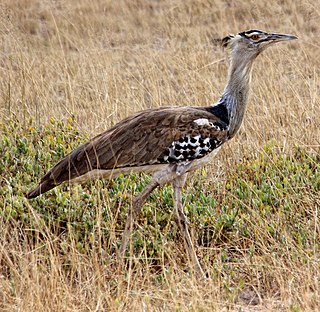
Otidae is a clade that includes the superorders Otidimorphae and Strisores. It was identified in 2014 by genome analysis. Earlier it was thought that Strisores was closely related to birds such as pigeons, flamingos, tropicbirds, and the sunbittern and kagu in the taxon Metaves, but subsequent work has provided evidence that Metaves is polyphyletic. Although analyses of genome data provided relatively high support for monophyly of Otidae, indicating that it is sister to all other Passerea clades, other analyses of large data matrices have not recovered a clade comprising Otidimorphae and Strisores, raising questions about the monophyly of Otidae.
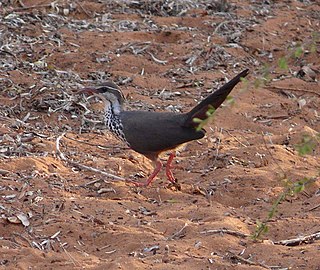
The mesites (Mesitornithidae) are a family of birds that are part of a clade (Columbimorphae) that include Columbiformes and Pterocliformes. They are smallish flightless or near flightless birds endemic to Madagascar. They are the only family with more than two species in which every species is threatened.
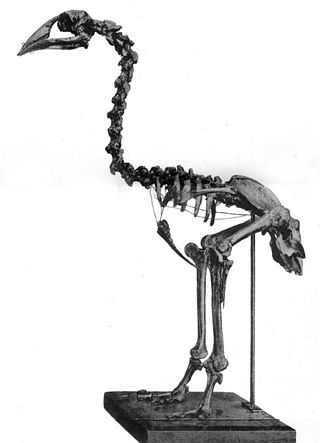
The adzebills, genus Aptornis, were two closely related bird species, the North Island adzebill,, and the South Island adzebill,, of the extinct family Aptornithidae. The family was endemic to New Zealand. A tentative fossil species,, is known from the Miocene Saint Bathans fauna.

A sea eagle or fish eagle is any of the birds of prey in the subfamily Haliaeetinae of the bird of prey family Accipitridae. Ten extant species exist, currently described with this label.

Rhynochetos is a genus of ground-dwelling birds in the monotypic family Rhynochetidae. It contains two species, both endemic to New Caledonia, one of which is extinct.
Polarornis is a genus of prehistoric bird, possibly an anserimorph. It contains a single species Polarornis gregorii, known from incomplete remains of one individual found on Seymour Island, Antarctica, in rocks which are dated to the Late Cretaceous.

The Phaethontiformes are an order of birds. They contain one extant family, the tropicbirds (Phaethontidae), and one extinct family Prophaethontidae from the early Cenozoic. Several fossil genera have been described, with well-preserved fossils known as early as the Paleocene. The group's origins may lie even earlier if the enigmatic waterbird Novacaesareala from the latest Cretaceous or earliest Paleocene of New Jersey is considered a tropicbird.
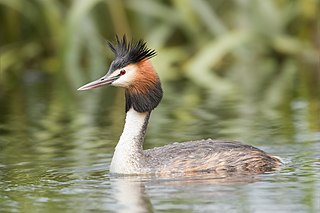
Neoaves is a clade that consists of all modern birds with the exception of Palaeognathae and Galloanserae. This group is defined in the PhyloCode by George Sangster and colleagues in 2022 as "the most inclusive crown clade containing Passer domesticus, but not Gallus gallus". Almost 95% of the roughly 10,000 known species of extant birds belong to the Neoaves.
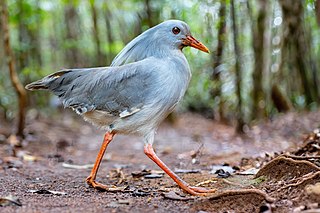
The kagu or cagou is a crested, long-legged, and bluish-grey bird endemic to the dense mountain forests of New Caledonia. It is the only surviving member of the genus Rhynochetos and the family Rhynochetidae, although a second species has been described from the fossil record.

Aequornithes, or core water birds, are defined in the PhyloCode as "the least inclusive crown clade containing Pelecanus onocrotalus and Gavia immer".
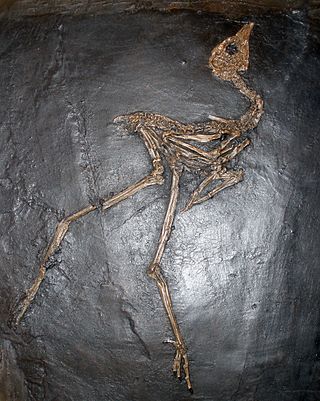
Messelornis, also known as the Messel rail, is an extinct genus of gruiform bird, closely related to modern rails. It is the most abundant bird from the Messel Lagerstätte, representing roughly half of all Messel bird fossils with more than 500 specimens known. The fossil record are from the Paleocene to the early Eocene.
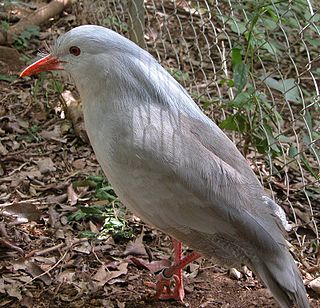
Eurypygiformes is an order formed by the kagus, comprising two species in the family Rhynochetidae endemic to New Caledonia, and the sunbittern from the tropical regions of the Americas. Its closest relatives appear to be the tropicbirds of the tropical Atlantic, Indian, and Pacific oceans.

Metaves is a controversial group proposed by Fain & Houde (2004) and later rescued on the studies of Ericson et al. (2006) and Hackett et al. (2008). This group consists of several lineages that diversified early in Neornithes evolution. These lineages include Strisores, pigeons, sandgrouses, mesites, Eurypygae, tropicbirds and Mirandornithes, but the exact members of Metaves and their relationship differs between those studies, and the group is only supported by the β-fibrinogen gene.
The lowland kagu is a large, extinct species of kagu. It was endemic to the island of New Caledonia in Melanesia in the south-west Pacific region. It was described from subfossil bones found at the Pindai Caves paleontological site on the west coast of Grande Terre. The holotype is a right tibiotarsus, held by the Muséum national d'histoire naturelle in Paris. The specific epithet comes from the Latin orarius from its presumed lowland distribution, as opposed to its congener the living kagu R. jubatus.
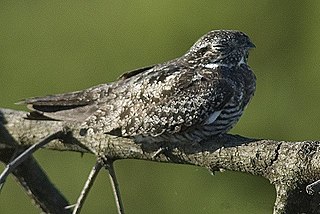
Strisores, sometimes called nightbirds, is a clade of birds that includes the living families and orders Caprimulgidae, Nyctibiidae (potoos), Steatornithidae (oilbirds), Podargidae (frogmouths), Apodiformes, as well as the Aegotheliformes (owlet-nightjars) whose distinctness was only recently realized. The Apodiformes and the Aegotheliformes form the Daedalornithes.
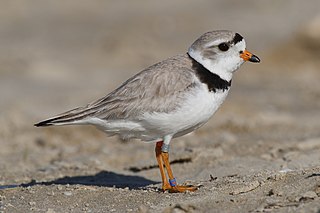
Gruimorphae is a clade of birds that contains the orders Charadriiformes and Gruiformes identified by molecular analysis. This grouping has had historical support, as various charadriiform families such as the families Pedionomidae and Turnicidae were classified as gruiforms. It may also have support from the fossil record since the discovery of Nahmavis from the Early Eocene of North America.
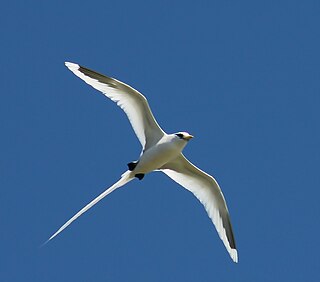
Eurypygimorphae or Phaethontimorphae is a clade of birds that contains the orders Phaethontiformes (tropicbirds) and Eurypygiformes recovered by genome analysis. The relationship was first identified in 2013 based on their nuclear genes. This group was defined in the PhyloCode by George Sangster and colleagues in 2022 as "the least inclusive crown clade containing Phaethon aethereus, Eurypyga helias, and Rhynochetos jubatus". Historically these birds were placed at different parts of the tree, with tropicbirds in Pelecaniformes and the kagu and sunbittern in Gruiformes. Some genetic analyses have placed the eurypygimorph taxa in the controversial and obsolete clade Metaves, with uncertain placement within that group. More recent molecular studies support their grouping together in Eurypygimorphae, which is usually recovered as the sister taxon to Aequornithes within Ardeae.

Columbaves is a clade that contains Columbimorphae and Otidimorphae discovered by genomic analysis by Prum et al. (2015). This conflicts with the Columbea and Otidae hypotheses which Mirandornithes are the sister taxon to Columbimorphae and Cypselomorphae the sister taxon to Otidimorphae, respectively, found by Jarvis et al. (2014). Neither hypothesis supports the two subdivisions of Metaves and Coronoaves as previous studies had found.























